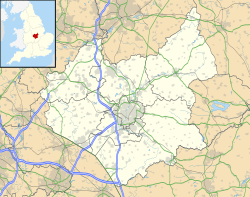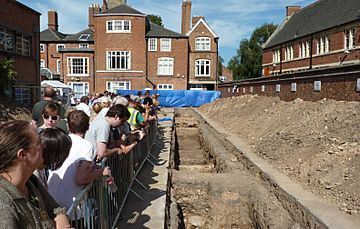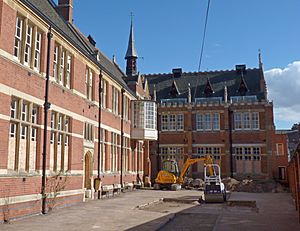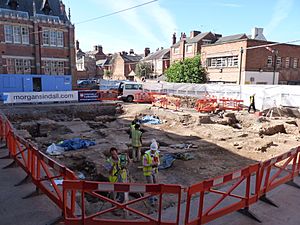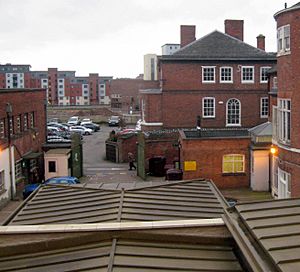Greyfriars, Leicester facts for kids

Greyfriars site superimposed on a modern map of the area. Richard III's burial site is shown by a small dot.
|
|
| Monastery information | |
|---|---|
| Other names | Leicester Franciscan Friary |
| Order | Order of Friars Minor |
| Established | Before 1230 |
| Disestablished | 1538 |
| Dedicated to | Unclear: Possibly Saint Francis of Assisi or Saint Mary Magdalene |
| Diocese | Lincoln |
| People | |
| Founder(s) | Unclear Traditionally credited but unlikely: Simon de Montfort, 6th Earl of Leicester Suggested either: Gilbert and Ellen Luenor, or John Pickering |
| Site | |
| Location | Leicester |
| Coordinates | 52°38′02″N 1°08′11″W / 52.634007°N 1.136431°W |
| Grid reference | SK58650434 |
| Visible remains | None |
Greyfriars, Leicester, was a special kind of monastery called a friary. It belonged to the Order of Friars Minor, also known as the Franciscans or "Grey Friars." It was built in Leicester around 1250. Later, in 1538, it was closed down.
After it closed, the friary buildings were taken down. The land was then divided up and built on over many years. Even today, the area is still called Greyfriars. You can find streets named "Grey Friars" and "Friar Lane" there.
This friary is most famous as the burial place of King Richard III. He was quickly buried in the friary church after he died at the Battle of Bosworth. In 2012 and 2013, an archaeological dig found the exact spot of the Greyfriars church. They also found where Richard III was buried. This grave site is now part of the 'Dynasty, Death and Discovery' museum, which opened in 2014.
Contents
The Franciscan Friary in Leicester
The Franciscan friars, also called "grey friars" because of their grey robes, first came to Britain in 1224. This was just two years before St Francis died. Nine friars arrived from France in Canterbury. They quickly gained new members.
By 1225, they had places in London and Oxford. These were simple rooms, as the friars promised to live in poverty. They soon expanded to other towns like Cambridge and Norwich. Friars arrived in Leicester before 1230. By 1237, Leicester was important enough to have teachers for new friars. By 1255, there were 1,242 friars in 49 houses across England.
It's not clear how the Leicester friars got their land. It's thought to have been given to them in the mid-1200s. Some people traditionally said Simon de Montfort, 6th Earl of Leicester helped. Others suggested Gilbert and Ellen Luenor, or John Pickering, were the founders. During the 2013 dig, a stone coffin was found in front of the church's main altar. It likely held a woman who was a very important helper, but her name is still unknown.
The friary was built inside Leicester's town walls. It had gates leading to Peacock Lane and Friar Lane. The exact spot of the church was only confirmed by the 2012 archaeological dig. The church was in the north-east part of the land. The cloisters (covered walkways) and other buildings were to the south.
The church's choir area was finished around 1255. It was about 10.4 meters (34 feet) wide. King Henry III even gave them oak trees to make stalls and decorate their chapel. The nave (the main part of the church) was finished around 1300.
In 1402, some friars from Leicester were involved in a plot. They wanted to support the old king, King Richard II, instead of the new one, King Henry IV. One friar admitted that he and ten other friars had planned against the king. Eight friars and a priest were arrested and sent to London. They were found guilty and executed. The two friars who escaped were caught later and also executed. After this, the Franciscan leaders held a meeting in Leicester. They strictly told all members not to speak against the king.
In 1414, King Henry V held Parliament in Leicester. The important lords met in the Greyfriars Friary's 'Large Hall'. The common people met in "La Fermerie," which was the friary's hospital. This building was outside the town wall. After the friary closed, it became a barn. Later, in the 1700s, it was used by Methodists for their meetings.
The Friary Closes Down
The Greyfriars friary was closed in 1538. This was part of King Henry VIII's plan to close down monasteries across England. At that time, the friary was very poor. It had a tiny income of only £1. 2s. per year. It only owned the land it sat on. The friary was home to the warden, William Gyllys, and six other friars.
Richard III's Burial Site
In 1485, King Richard III died fighting Henry Tudor at Bosworth Field. His body was brought to Leicester and displayed for several days. Then, he was buried in the Greyfriars Church. Ten years later, Henry VII paid for a fancy marble tomb for Richard. This was a good price for a high-status tomb.
It was thought that Richard's tomb and the church were destroyed after 1536. A story grew that Richard's bones were thrown into the River Soar. However, many historians believed this was just a legend.
In 2012, archaeologists from the University of Leicester, along with the Richard III Society and Leicester City Council, started a dig. They dug three trenches in a car park behind some buildings on Greyfriars. These digs found the walls of the cloisters and the church. This helped them figure out the layout of the old buildings. They also found a complete skeleton of a man. He had a curved spine (scoliosis) and serious head wounds.
On February 4, 2013, the University of Leicester confirmed that the skeleton was indeed Richard III. They did many tests, including comparing his DNA with people related to Richard III's older sister. The DNA matched, the age of the bones was right, and the injuries fit what was known about Richard's death.
What Happened After the Friary Closed
After the friary closed, the church and other buildings were bought by two men, John Bellowe and John Broxholme. They tore down the buildings in 1538. They sold the stones and wood. Some of these materials were used to fix St Martin's Church (now the Cathedral). The 2012 dig found the original wall trenches, filled with mortar from where the stones were removed. Some carved stones were found, but most had been reused elsewhere.
Herrick's Mansion
Sir Robert Catlyn, a judge for Queen Elizabeth I, later bought the site. Then, Robert Herrick, who was mayor of Leicester three times, bought it. Herrick built a large house (mansion) facing Friar Lane. It had big gardens over the eastern part of the friary grounds. In 1611, Christopher Wren Sr. visited these gardens. He wrote about seeing a stone pillar with an inscription: "Here lies the body of Richard III, some time King of England."
The Herrick family sold the mansion in 1711 to Thomas Noble.
Later Buildings and Changes
In 1740, Thomas Noble's son, also named Thomas, built a road across the Greyfriars site. It went from near St Martin's Church to Friar Lane. This road was called "New Street." It created new plots of land for smaller buildings. Many Georgian buildings were built along New Street and Friar Lane in the mid to late 1700s. Many of these buildings are still there today.
In 1752, the mansion and gardens were sold to Richard Garle. He then sold them in 1776 to Thomas Pares, a banker. Pares made the mansion bigger. He also built a bank building at the very east end of the site. This bank later became part of the National Westminster Bank.
When Pares died in 1824, most of the property was sold. The mansion was then known as "The Grey Friars." It was divided into parts.
School Buildings
In 1863, a plot of land was sold to the trustees of Alderman Newton's Boys School. This allowed the school to move to a new location. The area was described as "very open" with "several large gardens." The school was built in 1864 and made bigger in 1887 and 1897.
In 1920, Alderman Newton's School moved again. The old school buildings became a girls' school and then a preparatory school. Later, they were used by Leicester Grammar School. When Leicester Grammar School moved, the buildings became offices. In the 2012 archaeological dig, one of the trenches was in the former playground of this school. In 2013, Leicester City Council bought the buildings. They announced that it would become a museum for Richard III.
Council Offices and Other Buildings
The Leicester Corporation bought the two parts of the mansion and its gardens in 1866. They first wanted to build a new Town Hall there. But in 1872, they decided to use a different site. At the mansion site, they tore down the house and created a new road called "Grey Friars." This road quickly got several nice Victorian commercial buildings.
For example, the Leicester Savings Bank was built in 1873. The Conway Buildings, used for offices, were built in 1878. In 1880, Barradale's architects office was built. Ernest Gimson, a famous designer, worked in these offices from 1881 to 1885. A 20th-century building was built in 1936 where Herrick's Mansion once stood. It was used as offices for Leicestershire County Council until 1965.
The buildings along Grey Friars, Friar Lane, New Street, and St Martins surround an area that has been car parks and school yards for over a century. Before that, it was gardens for 300 years. The archaeological dig in 2012 showed that much of the Greyfriars Church foundations, including Richard III's grave, were in this area and had been untouched all that time.
Archaeological Discoveries
Besides finding Richard III's remains, the dig in August 2012 also found parts of the medieval friary. This included the walls of the Friary Church's chancel (the area around the altar). They also found a cloister area and a chapter house with stone benches. Clues about the building materials, stone choir seats, floor tiles, and a window were also found. Three other graves, including a stone coffin, were found but left untouched.
In July 2013, the University of Leicester Archaeological Service led another month-long dig. This dig was wider and aimed to find more information for the visitor center. They found floor tiles, pottery, and small items. They also found a mysterious building south of the Chancel, which might be older than the church. The three grave sites in the Chancel were also explored. One massive stone coffin in front of the main altar had an intact lead coffin inside. Early findings suggest the person inside was a woman, likely a rich helper of the friary.
Richard III Visitor Centre
After confirming Richard III's burial place in February 2013, Leicester City Council announced plans. They would turn the old Alderman Newton's school buildings into a Richard III Visitor Centre. It's called 'Richard III: Dynasty, Death and Discovery'. It has a covered area over the original grave site. An upstairs viewing platform shows how the Greyfriars site and medieval Leicester might have looked. A temporary exhibit showed items from the dig until the main museum opened in July 2014.
In July 2013, Leicester Cathedral announced plans to re-bury Richard III there in May 2014. However, some people wanted him re-buried in York and asked a court to review the decision. In August 2013, a judge allowed a review. But in May 2014, the court ruled that they could not interfere. So, plans were made for Richard III to be re-buried in Leicester Cathedral in the spring of 2015. This happened on March 26, with members of the Royal Family and the Archbishop of Canterbury present.


